International Marketing: Lee's Employment in a Korean Company
VerifiedAdded on 2020/03/02
|11
|2328
|46
Report
AI Summary
This report analyzes a case study concerning Lee's employment in a Korean company, focusing on the challenges he faces due to cultural differences and organizational dynamics. It applies Hofstede's cultural dimension theory to understand Lee's situation, highlighting the impact of individualism versus collectivism, power distance, and other dimensions. The report provides practical recommendations for Lee to improve his situation and retain his position, including the importance of communication, professionalism, and ethical behavior. Furthermore, it offers insights into how Korean managers can effectively deal with individualistic employees, emphasizing the value of team-building activities, motivation, and acknowledging employee suggestions and problems. The conclusion summarizes the key findings and reinforces the importance of understanding and adapting to cultural differences in international marketing and management. The report provides valuable insights for students of leadership and management, with a focus on international marketing.
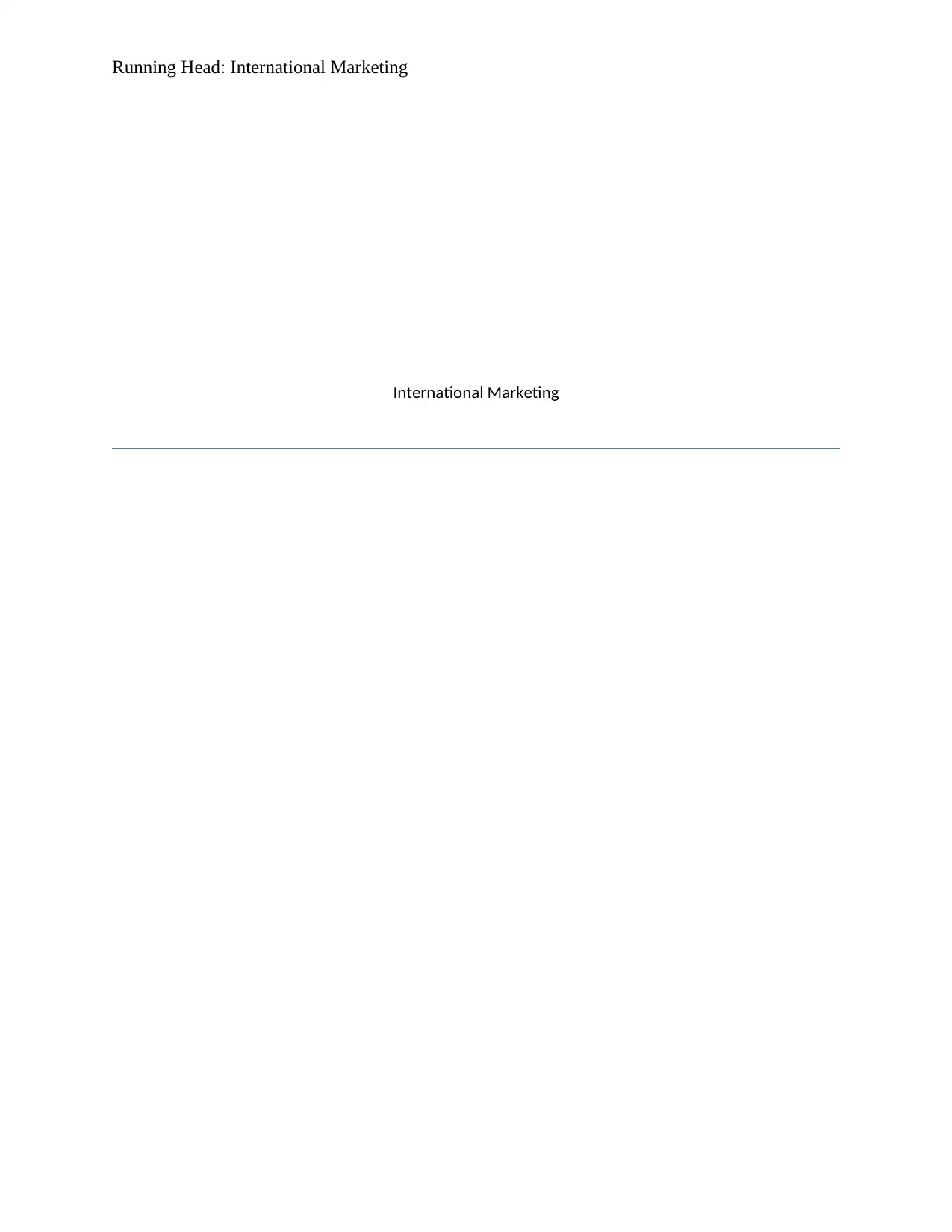
Running Head: International Marketing
International Marketing
International Marketing
Paraphrase This Document
Need a fresh take? Get an instant paraphrase of this document with our AI Paraphraser
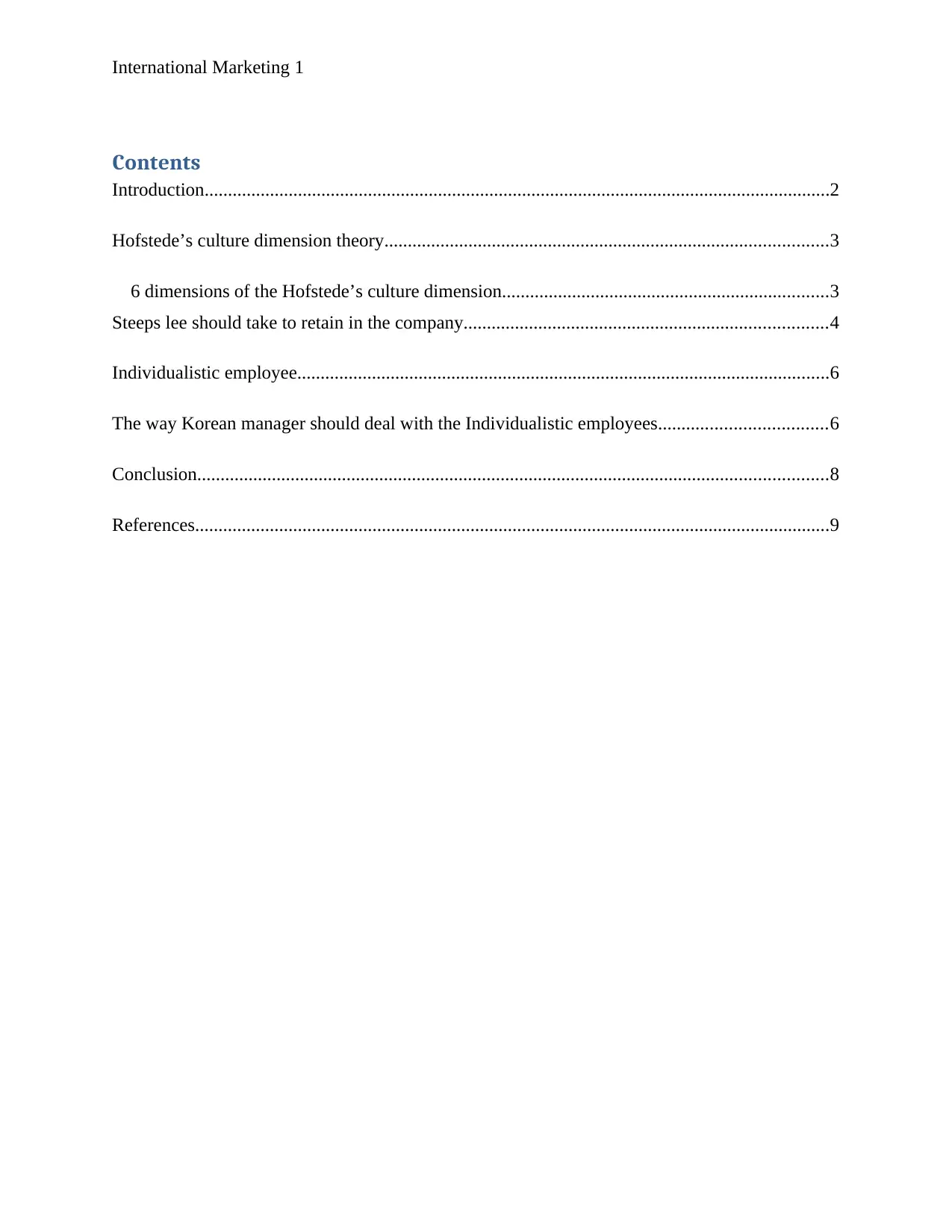
International Marketing 1
Contents
Introduction......................................................................................................................................2
Hofstede’s culture dimension theory...............................................................................................3
6 dimensions of the Hofstede’s culture dimension......................................................................3
Steeps lee should take to retain in the company..............................................................................4
Individualistic employee..................................................................................................................6
The way Korean manager should deal with the Individualistic employees....................................6
Conclusion.......................................................................................................................................8
References........................................................................................................................................9
Contents
Introduction......................................................................................................................................2
Hofstede’s culture dimension theory...............................................................................................3
6 dimensions of the Hofstede’s culture dimension......................................................................3
Steeps lee should take to retain in the company..............................................................................4
Individualistic employee..................................................................................................................6
The way Korean manager should deal with the Individualistic employees....................................6
Conclusion.......................................................................................................................................8
References........................................................................................................................................9
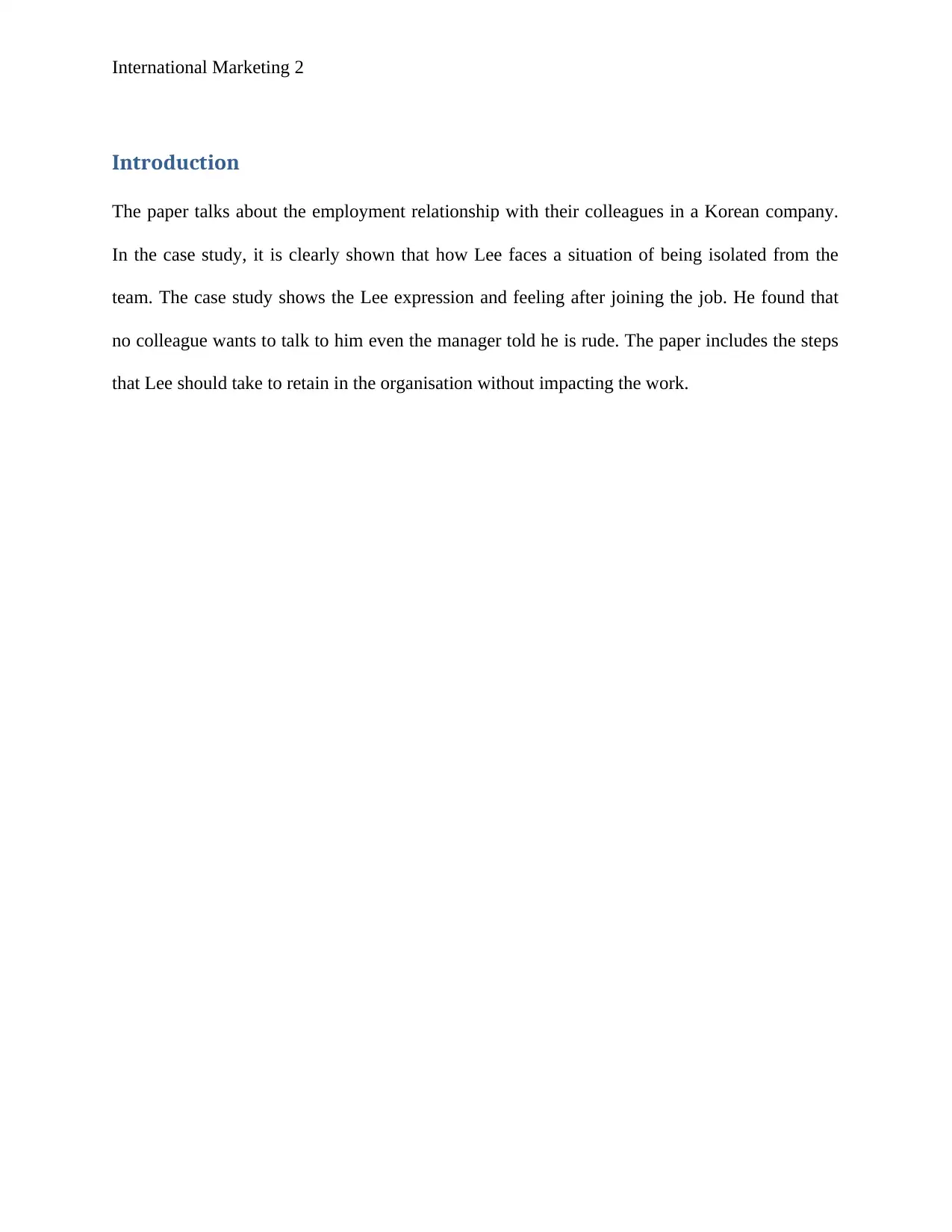
International Marketing 2
Introduction
The paper talks about the employment relationship with their colleagues in a Korean company.
In the case study, it is clearly shown that how Lee faces a situation of being isolated from the
team. The case study shows the Lee expression and feeling after joining the job. He found that
no colleague wants to talk to him even the manager told he is rude. The paper includes the steps
that Lee should take to retain in the organisation without impacting the work.
Introduction
The paper talks about the employment relationship with their colleagues in a Korean company.
In the case study, it is clearly shown that how Lee faces a situation of being isolated from the
team. The case study shows the Lee expression and feeling after joining the job. He found that
no colleague wants to talk to him even the manager told he is rude. The paper includes the steps
that Lee should take to retain in the organisation without impacting the work.
⊘ This is a preview!⊘
Do you want full access?
Subscribe today to unlock all pages.

Trusted by 1+ million students worldwide
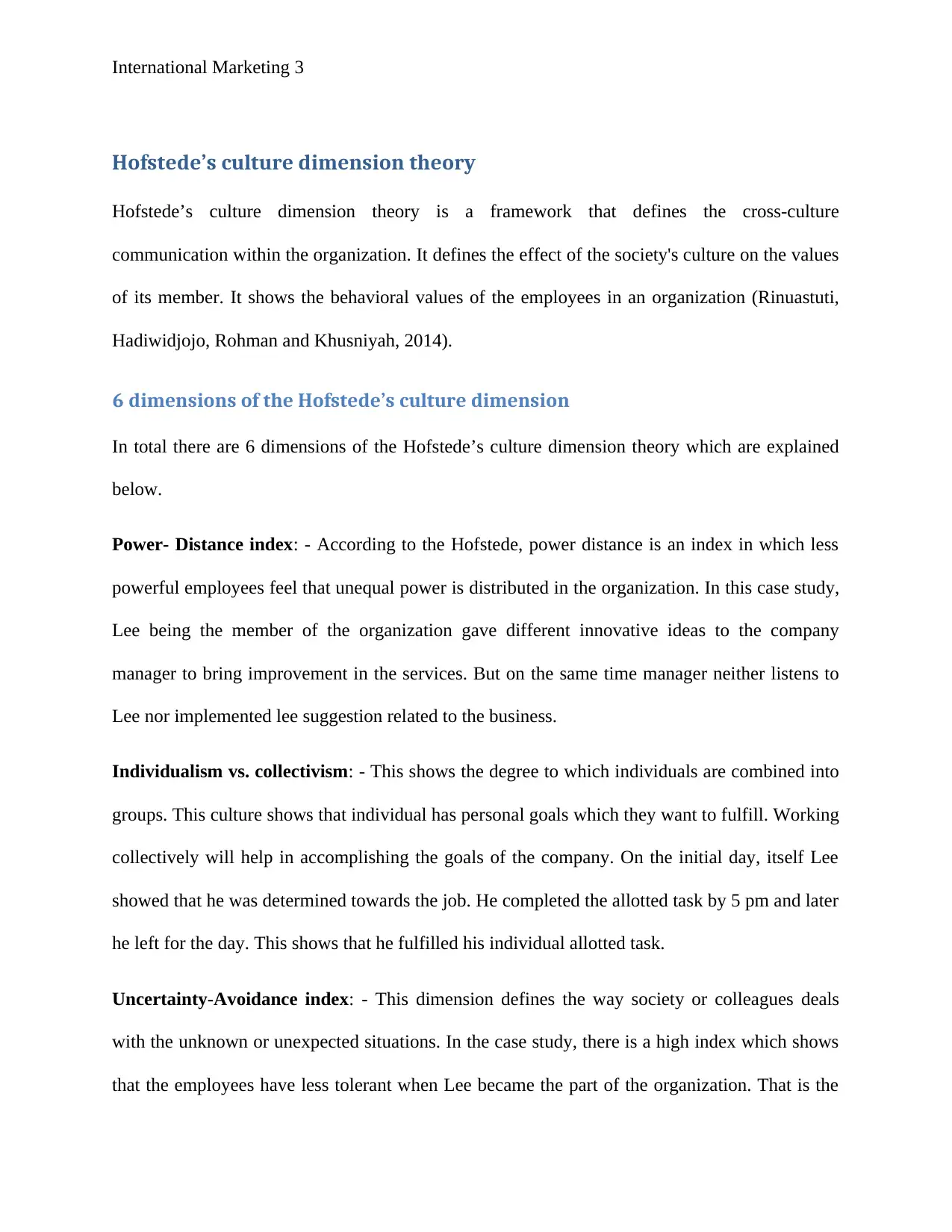
International Marketing 3
Hofstede’s culture dimension theory
Hofstede’s culture dimension theory is a framework that defines the cross-culture
communication within the organization. It defines the effect of the society's culture on the values
of its member. It shows the behavioral values of the employees in an organization (Rinuastuti,
Hadiwidjojo, Rohman and Khusniyah, 2014).
6 dimensions of the Hofstede’s culture dimension
In total there are 6 dimensions of the Hofstede’s culture dimension theory which are explained
below.
Power- Distance index: - According to the Hofstede, power distance is an index in which less
powerful employees feel that unequal power is distributed in the organization. In this case study,
Lee being the member of the organization gave different innovative ideas to the company
manager to bring improvement in the services. But on the same time manager neither listens to
Lee nor implemented lee suggestion related to the business.
Individualism vs. collectivism: - This shows the degree to which individuals are combined into
groups. This culture shows that individual has personal goals which they want to fulfill. Working
collectively will help in accomplishing the goals of the company. On the initial day, itself Lee
showed that he was determined towards the job. He completed the allotted task by 5 pm and later
he left for the day. This shows that he fulfilled his individual allotted task.
Uncertainty-Avoidance index: - This dimension defines the way society or colleagues deals
with the unknown or unexpected situations. In the case study, there is a high index which shows
that the employees have less tolerant when Lee became the part of the organization. That is the
Hofstede’s culture dimension theory
Hofstede’s culture dimension theory is a framework that defines the cross-culture
communication within the organization. It defines the effect of the society's culture on the values
of its member. It shows the behavioral values of the employees in an organization (Rinuastuti,
Hadiwidjojo, Rohman and Khusniyah, 2014).
6 dimensions of the Hofstede’s culture dimension
In total there are 6 dimensions of the Hofstede’s culture dimension theory which are explained
below.
Power- Distance index: - According to the Hofstede, power distance is an index in which less
powerful employees feel that unequal power is distributed in the organization. In this case study,
Lee being the member of the organization gave different innovative ideas to the company
manager to bring improvement in the services. But on the same time manager neither listens to
Lee nor implemented lee suggestion related to the business.
Individualism vs. collectivism: - This shows the degree to which individuals are combined into
groups. This culture shows that individual has personal goals which they want to fulfill. Working
collectively will help in accomplishing the goals of the company. On the initial day, itself Lee
showed that he was determined towards the job. He completed the allotted task by 5 pm and later
he left for the day. This shows that he fulfilled his individual allotted task.
Uncertainty-Avoidance index: - This dimension defines the way society or colleagues deals
with the unknown or unexpected situations. In the case study, there is a high index which shows
that the employees have less tolerant when Lee became the part of the organization. That is the
Paraphrase This Document
Need a fresh take? Get an instant paraphrase of this document with our AI Paraphraser
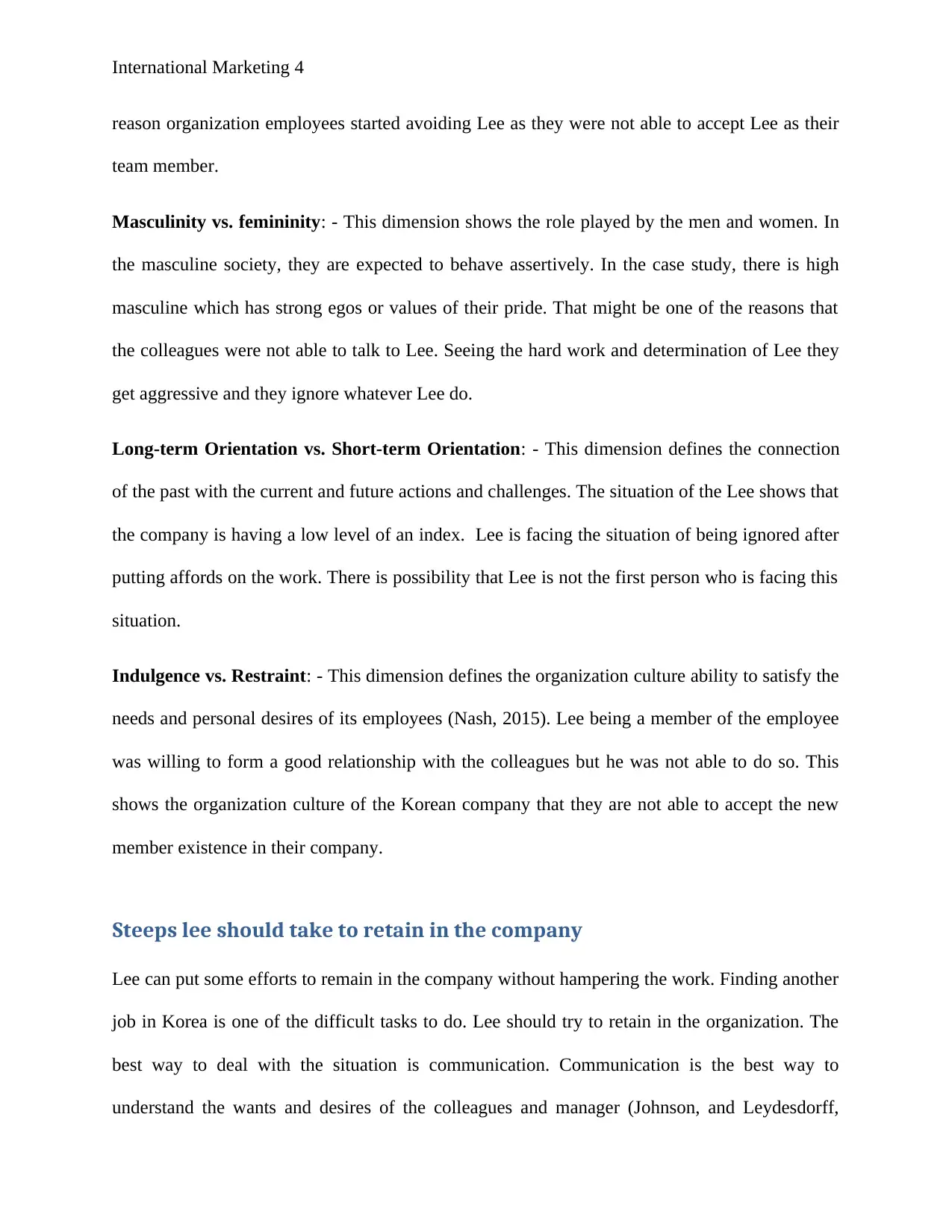
International Marketing 4
reason organization employees started avoiding Lee as they were not able to accept Lee as their
team member.
Masculinity vs. femininity: - This dimension shows the role played by the men and women. In
the masculine society, they are expected to behave assertively. In the case study, there is high
masculine which has strong egos or values of their pride. That might be one of the reasons that
the colleagues were not able to talk to Lee. Seeing the hard work and determination of Lee they
get aggressive and they ignore whatever Lee do.
Long-term Orientation vs. Short-term Orientation: - This dimension defines the connection
of the past with the current and future actions and challenges. The situation of the Lee shows that
the company is having a low level of an index. Lee is facing the situation of being ignored after
putting affords on the work. There is possibility that Lee is not the first person who is facing this
situation.
Indulgence vs. Restraint: - This dimension defines the organization culture ability to satisfy the
needs and personal desires of its employees (Nash, 2015). Lee being a member of the employee
was willing to form a good relationship with the colleagues but he was not able to do so. This
shows the organization culture of the Korean company that they are not able to accept the new
member existence in their company.
Steeps lee should take to retain in the company
Lee can put some efforts to remain in the company without hampering the work. Finding another
job in Korea is one of the difficult tasks to do. Lee should try to retain in the organization. The
best way to deal with the situation is communication. Communication is the best way to
understand the wants and desires of the colleagues and manager (Johnson, and Leydesdorff,
reason organization employees started avoiding Lee as they were not able to accept Lee as their
team member.
Masculinity vs. femininity: - This dimension shows the role played by the men and women. In
the masculine society, they are expected to behave assertively. In the case study, there is high
masculine which has strong egos or values of their pride. That might be one of the reasons that
the colleagues were not able to talk to Lee. Seeing the hard work and determination of Lee they
get aggressive and they ignore whatever Lee do.
Long-term Orientation vs. Short-term Orientation: - This dimension defines the connection
of the past with the current and future actions and challenges. The situation of the Lee shows that
the company is having a low level of an index. Lee is facing the situation of being ignored after
putting affords on the work. There is possibility that Lee is not the first person who is facing this
situation.
Indulgence vs. Restraint: - This dimension defines the organization culture ability to satisfy the
needs and personal desires of its employees (Nash, 2015). Lee being a member of the employee
was willing to form a good relationship with the colleagues but he was not able to do so. This
shows the organization culture of the Korean company that they are not able to accept the new
member existence in their company.
Steeps lee should take to retain in the company
Lee can put some efforts to remain in the company without hampering the work. Finding another
job in Korea is one of the difficult tasks to do. Lee should try to retain in the organization. The
best way to deal with the situation is communication. Communication is the best way to
understand the wants and desires of the colleagues and manager (Johnson, and Leydesdorff,
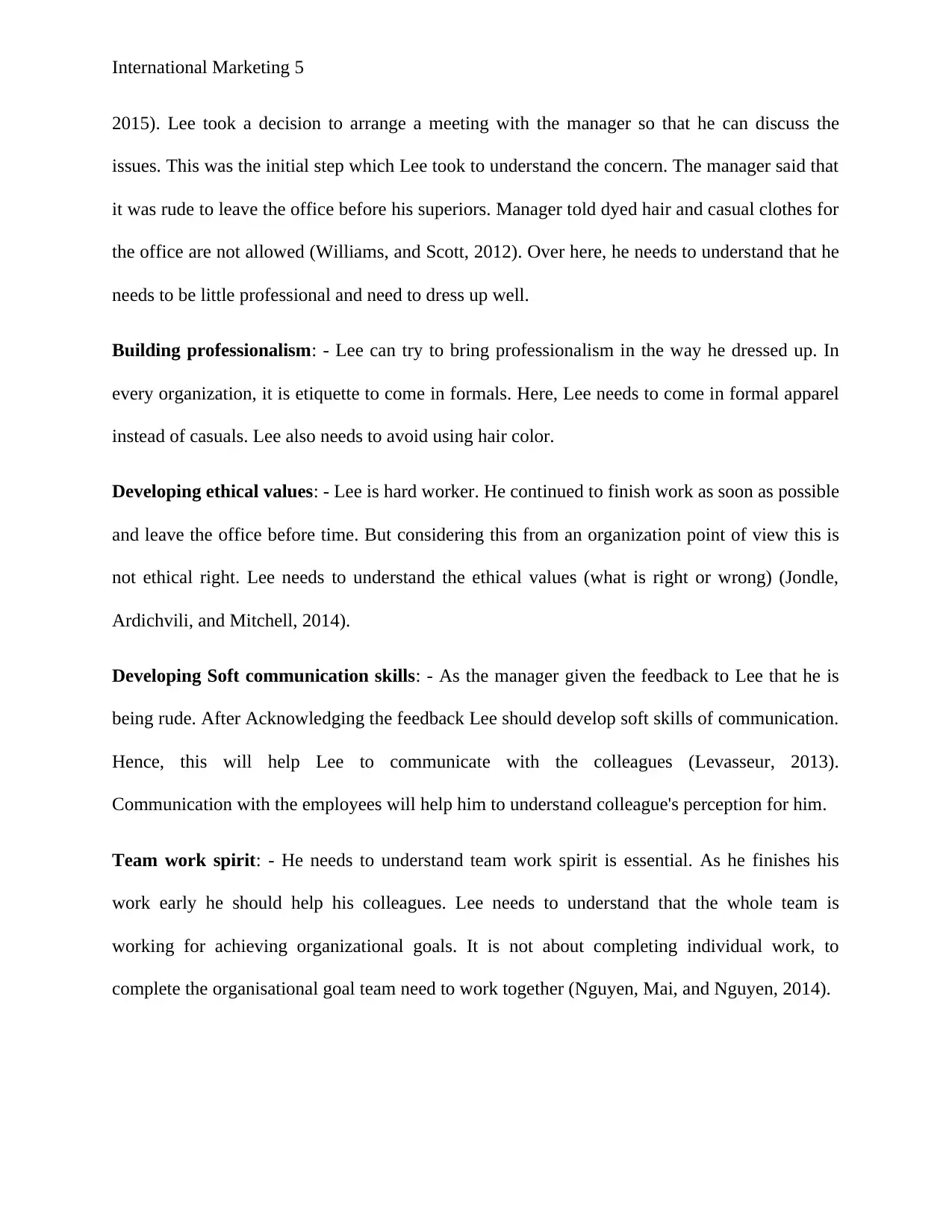
International Marketing 5
2015). Lee took a decision to arrange a meeting with the manager so that he can discuss the
issues. This was the initial step which Lee took to understand the concern. The manager said that
it was rude to leave the office before his superiors. Manager told dyed hair and casual clothes for
the office are not allowed (Williams, and Scott, 2012). Over here, he needs to understand that he
needs to be little professional and need to dress up well.
Building professionalism: - Lee can try to bring professionalism in the way he dressed up. In
every organization, it is etiquette to come in formals. Here, Lee needs to come in formal apparel
instead of casuals. Lee also needs to avoid using hair color.
Developing ethical values: - Lee is hard worker. He continued to finish work as soon as possible
and leave the office before time. But considering this from an organization point of view this is
not ethical right. Lee needs to understand the ethical values (what is right or wrong) (Jondle,
Ardichvili, and Mitchell, 2014).
Developing Soft communication skills: - As the manager given the feedback to Lee that he is
being rude. After Acknowledging the feedback Lee should develop soft skills of communication.
Hence, this will help Lee to communicate with the colleagues (Levasseur, 2013).
Communication with the employees will help him to understand colleague's perception for him.
Team work spirit: - He needs to understand team work spirit is essential. As he finishes his
work early he should help his colleagues. Lee needs to understand that the whole team is
working for achieving organizational goals. It is not about completing individual work, to
complete the organisational goal team need to work together (Nguyen, Mai, and Nguyen, 2014).
2015). Lee took a decision to arrange a meeting with the manager so that he can discuss the
issues. This was the initial step which Lee took to understand the concern. The manager said that
it was rude to leave the office before his superiors. Manager told dyed hair and casual clothes for
the office are not allowed (Williams, and Scott, 2012). Over here, he needs to understand that he
needs to be little professional and need to dress up well.
Building professionalism: - Lee can try to bring professionalism in the way he dressed up. In
every organization, it is etiquette to come in formals. Here, Lee needs to come in formal apparel
instead of casuals. Lee also needs to avoid using hair color.
Developing ethical values: - Lee is hard worker. He continued to finish work as soon as possible
and leave the office before time. But considering this from an organization point of view this is
not ethical right. Lee needs to understand the ethical values (what is right or wrong) (Jondle,
Ardichvili, and Mitchell, 2014).
Developing Soft communication skills: - As the manager given the feedback to Lee that he is
being rude. After Acknowledging the feedback Lee should develop soft skills of communication.
Hence, this will help Lee to communicate with the colleagues (Levasseur, 2013).
Communication with the employees will help him to understand colleague's perception for him.
Team work spirit: - He needs to understand team work spirit is essential. As he finishes his
work early he should help his colleagues. Lee needs to understand that the whole team is
working for achieving organizational goals. It is not about completing individual work, to
complete the organisational goal team need to work together (Nguyen, Mai, and Nguyen, 2014).
⊘ This is a preview!⊘
Do you want full access?
Subscribe today to unlock all pages.

Trusted by 1+ million students worldwide
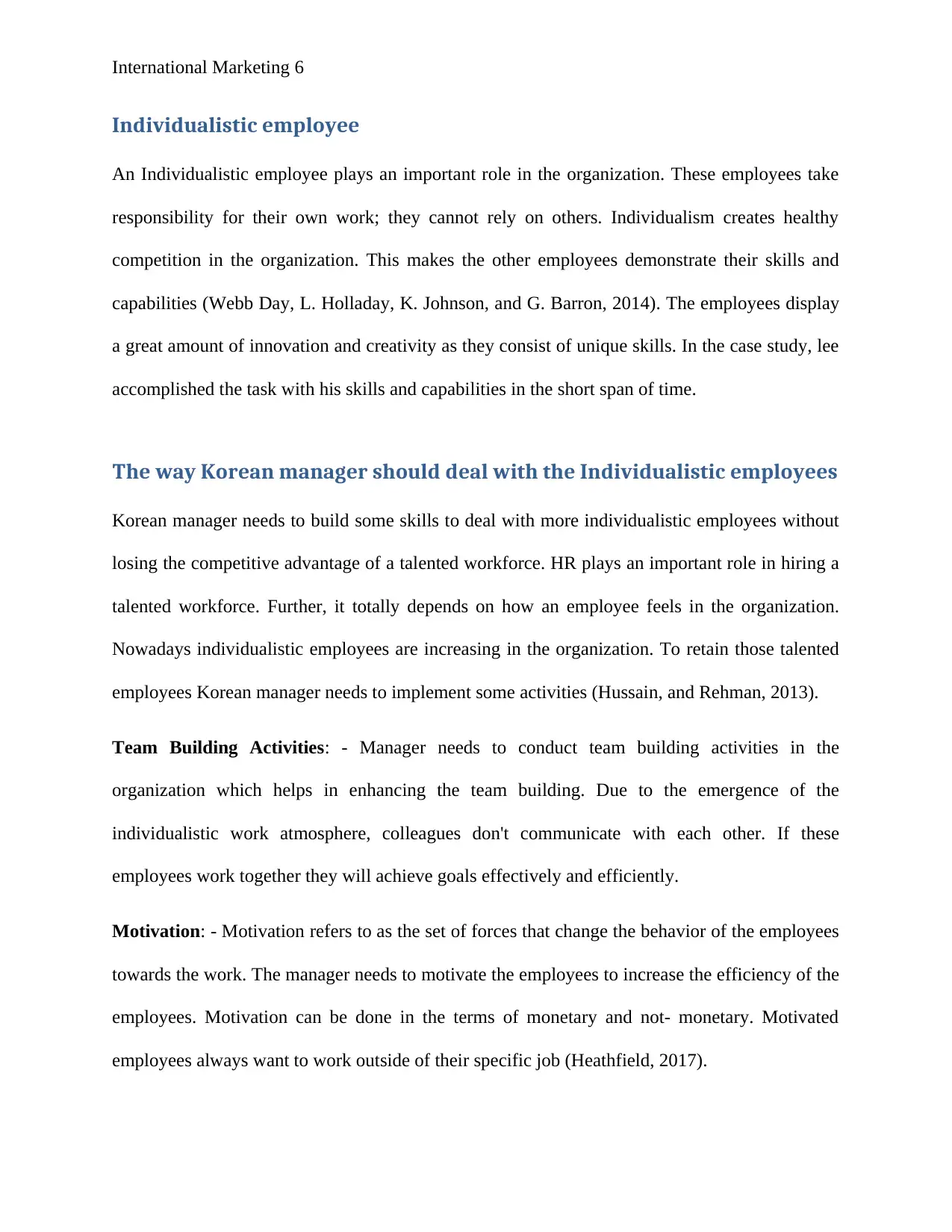
International Marketing 6
Individualistic employee
An Individualistic employee plays an important role in the organization. These employees take
responsibility for their own work; they cannot rely on others. Individualism creates healthy
competition in the organization. This makes the other employees demonstrate their skills and
capabilities (Webb Day, L. Holladay, K. Johnson, and G. Barron, 2014). The employees display
a great amount of innovation and creativity as they consist of unique skills. In the case study, lee
accomplished the task with his skills and capabilities in the short span of time.
The way Korean manager should deal with the Individualistic employees
Korean manager needs to build some skills to deal with more individualistic employees without
losing the competitive advantage of a talented workforce. HR plays an important role in hiring a
talented workforce. Further, it totally depends on how an employee feels in the organization.
Nowadays individualistic employees are increasing in the organization. To retain those talented
employees Korean manager needs to implement some activities (Hussain, and Rehman, 2013).
Team Building Activities: - Manager needs to conduct team building activities in the
organization which helps in enhancing the team building. Due to the emergence of the
individualistic work atmosphere, colleagues don't communicate with each other. If these
employees work together they will achieve goals effectively and efficiently.
Motivation: - Motivation refers to as the set of forces that change the behavior of the employees
towards the work. The manager needs to motivate the employees to increase the efficiency of the
employees. Motivation can be done in the terms of monetary and not- monetary. Motivated
employees always want to work outside of their specific job (Heathfield, 2017).
Individualistic employee
An Individualistic employee plays an important role in the organization. These employees take
responsibility for their own work; they cannot rely on others. Individualism creates healthy
competition in the organization. This makes the other employees demonstrate their skills and
capabilities (Webb Day, L. Holladay, K. Johnson, and G. Barron, 2014). The employees display
a great amount of innovation and creativity as they consist of unique skills. In the case study, lee
accomplished the task with his skills and capabilities in the short span of time.
The way Korean manager should deal with the Individualistic employees
Korean manager needs to build some skills to deal with more individualistic employees without
losing the competitive advantage of a talented workforce. HR plays an important role in hiring a
talented workforce. Further, it totally depends on how an employee feels in the organization.
Nowadays individualistic employees are increasing in the organization. To retain those talented
employees Korean manager needs to implement some activities (Hussain, and Rehman, 2013).
Team Building Activities: - Manager needs to conduct team building activities in the
organization which helps in enhancing the team building. Due to the emergence of the
individualistic work atmosphere, colleagues don't communicate with each other. If these
employees work together they will achieve goals effectively and efficiently.
Motivation: - Motivation refers to as the set of forces that change the behavior of the employees
towards the work. The manager needs to motivate the employees to increase the efficiency of the
employees. Motivation can be done in the terms of monetary and not- monetary. Motivated
employees always want to work outside of their specific job (Heathfield, 2017).
Paraphrase This Document
Need a fresh take? Get an instant paraphrase of this document with our AI Paraphraser
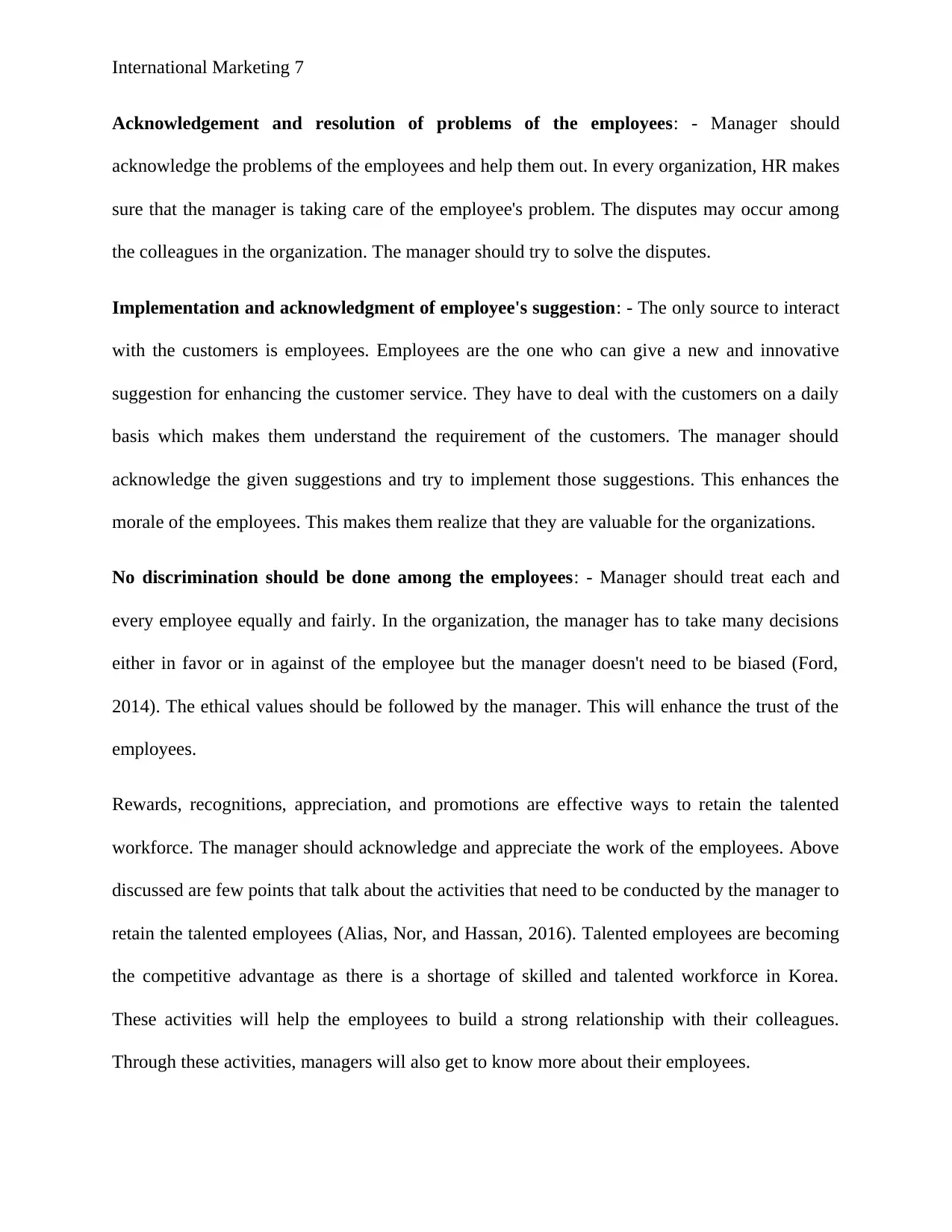
International Marketing 7
Acknowledgement and resolution of problems of the employees: - Manager should
acknowledge the problems of the employees and help them out. In every organization, HR makes
sure that the manager is taking care of the employee's problem. The disputes may occur among
the colleagues in the organization. The manager should try to solve the disputes.
Implementation and acknowledgment of employee's suggestion: - The only source to interact
with the customers is employees. Employees are the one who can give a new and innovative
suggestion for enhancing the customer service. They have to deal with the customers on a daily
basis which makes them understand the requirement of the customers. The manager should
acknowledge the given suggestions and try to implement those suggestions. This enhances the
morale of the employees. This makes them realize that they are valuable for the organizations.
No discrimination should be done among the employees: - Manager should treat each and
every employee equally and fairly. In the organization, the manager has to take many decisions
either in favor or in against of the employee but the manager doesn't need to be biased (Ford,
2014). The ethical values should be followed by the manager. This will enhance the trust of the
employees.
Rewards, recognitions, appreciation, and promotions are effective ways to retain the talented
workforce. The manager should acknowledge and appreciate the work of the employees. Above
discussed are few points that talk about the activities that need to be conducted by the manager to
retain the talented employees (Alias, Nor, and Hassan, 2016). Talented employees are becoming
the competitive advantage as there is a shortage of skilled and talented workforce in Korea.
These activities will help the employees to build a strong relationship with their colleagues.
Through these activities, managers will also get to know more about their employees.
Acknowledgement and resolution of problems of the employees: - Manager should
acknowledge the problems of the employees and help them out. In every organization, HR makes
sure that the manager is taking care of the employee's problem. The disputes may occur among
the colleagues in the organization. The manager should try to solve the disputes.
Implementation and acknowledgment of employee's suggestion: - The only source to interact
with the customers is employees. Employees are the one who can give a new and innovative
suggestion for enhancing the customer service. They have to deal with the customers on a daily
basis which makes them understand the requirement of the customers. The manager should
acknowledge the given suggestions and try to implement those suggestions. This enhances the
morale of the employees. This makes them realize that they are valuable for the organizations.
No discrimination should be done among the employees: - Manager should treat each and
every employee equally and fairly. In the organization, the manager has to take many decisions
either in favor or in against of the employee but the manager doesn't need to be biased (Ford,
2014). The ethical values should be followed by the manager. This will enhance the trust of the
employees.
Rewards, recognitions, appreciation, and promotions are effective ways to retain the talented
workforce. The manager should acknowledge and appreciate the work of the employees. Above
discussed are few points that talk about the activities that need to be conducted by the manager to
retain the talented employees (Alias, Nor, and Hassan, 2016). Talented employees are becoming
the competitive advantage as there is a shortage of skilled and talented workforce in Korea.
These activities will help the employees to build a strong relationship with their colleagues.
Through these activities, managers will also get to know more about their employees.
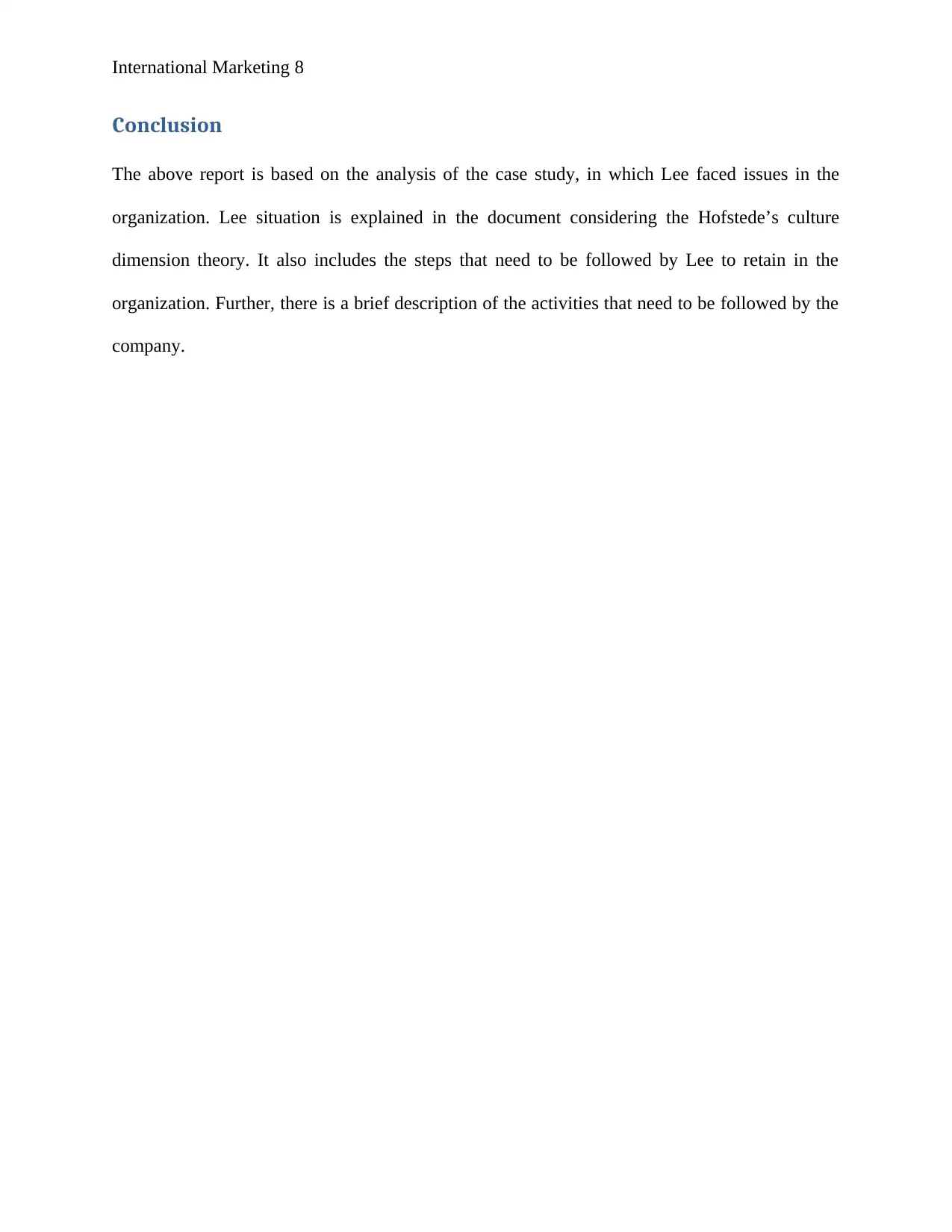
International Marketing 8
Conclusion
The above report is based on the analysis of the case study, in which Lee faced issues in the
organization. Lee situation is explained in the document considering the Hofstede’s culture
dimension theory. It also includes the steps that need to be followed by Lee to retain in the
organization. Further, there is a brief description of the activities that need to be followed by the
company.
Conclusion
The above report is based on the analysis of the case study, in which Lee faced issues in the
organization. Lee situation is explained in the document considering the Hofstede’s culture
dimension theory. It also includes the steps that need to be followed by Lee to retain in the
organization. Further, there is a brief description of the activities that need to be followed by the
company.
⊘ This is a preview!⊘
Do you want full access?
Subscribe today to unlock all pages.

Trusted by 1+ million students worldwide
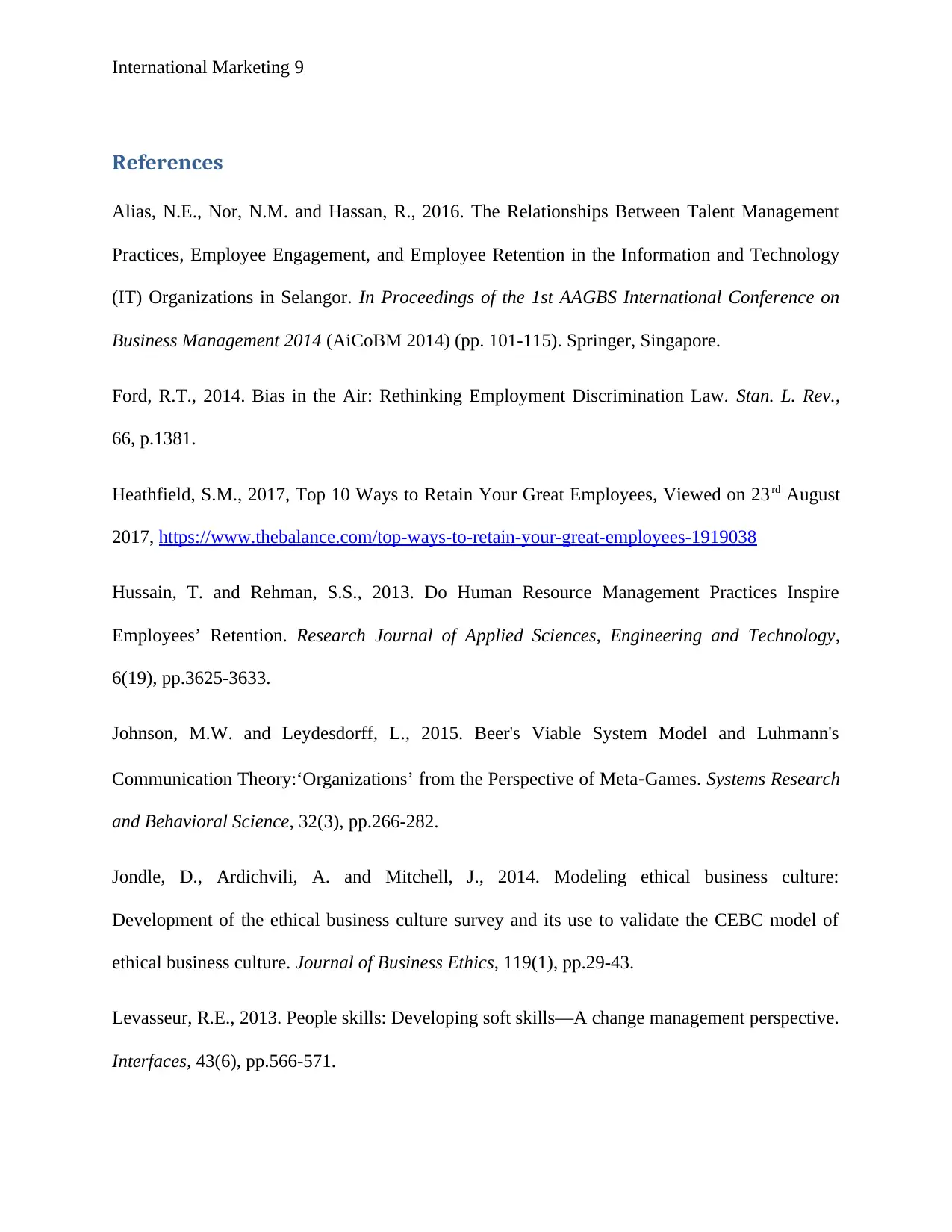
International Marketing 9
References
Alias, N.E., Nor, N.M. and Hassan, R., 2016. The Relationships Between Talent Management
Practices, Employee Engagement, and Employee Retention in the Information and Technology
(IT) Organizations in Selangor. In Proceedings of the 1st AAGBS International Conference on
Business Management 2014 (AiCoBM 2014) (pp. 101-115). Springer, Singapore.
Ford, R.T., 2014. Bias in the Air: Rethinking Employment Discrimination Law. Stan. L. Rev.,
66, p.1381.
Heathfield, S.M., 2017, Top 10 Ways to Retain Your Great Employees, Viewed on 23rd August
2017, https://www.thebalance.com/top-ways-to-retain-your-great-employees-1919038
Hussain, T. and Rehman, S.S., 2013. Do Human Resource Management Practices Inspire
Employees’ Retention. Research Journal of Applied Sciences, Engineering and Technology,
6(19), pp.3625-3633.
Johnson, M.W. and Leydesdorff, L., 2015. Beer's Viable System Model and Luhmann's
Communication Theory:‘Organizations’ from the Perspective of Meta‐Games. Systems Research
and Behavioral Science, 32(3), pp.266-282.
Jondle, D., Ardichvili, A. and Mitchell, J., 2014. Modeling ethical business culture:
Development of the ethical business culture survey and its use to validate the CEBC model of
ethical business culture. Journal of Business Ethics, 119(1), pp.29-43.
Levasseur, R.E., 2013. People skills: Developing soft skills—A change management perspective.
Interfaces, 43(6), pp.566-571.
References
Alias, N.E., Nor, N.M. and Hassan, R., 2016. The Relationships Between Talent Management
Practices, Employee Engagement, and Employee Retention in the Information and Technology
(IT) Organizations in Selangor. In Proceedings of the 1st AAGBS International Conference on
Business Management 2014 (AiCoBM 2014) (pp. 101-115). Springer, Singapore.
Ford, R.T., 2014. Bias in the Air: Rethinking Employment Discrimination Law. Stan. L. Rev.,
66, p.1381.
Heathfield, S.M., 2017, Top 10 Ways to Retain Your Great Employees, Viewed on 23rd August
2017, https://www.thebalance.com/top-ways-to-retain-your-great-employees-1919038
Hussain, T. and Rehman, S.S., 2013. Do Human Resource Management Practices Inspire
Employees’ Retention. Research Journal of Applied Sciences, Engineering and Technology,
6(19), pp.3625-3633.
Johnson, M.W. and Leydesdorff, L., 2015. Beer's Viable System Model and Luhmann's
Communication Theory:‘Organizations’ from the Perspective of Meta‐Games. Systems Research
and Behavioral Science, 32(3), pp.266-282.
Jondle, D., Ardichvili, A. and Mitchell, J., 2014. Modeling ethical business culture:
Development of the ethical business culture survey and its use to validate the CEBC model of
ethical business culture. Journal of Business Ethics, 119(1), pp.29-43.
Levasseur, R.E., 2013. People skills: Developing soft skills—A change management perspective.
Interfaces, 43(6), pp.566-571.
Paraphrase This Document
Need a fresh take? Get an instant paraphrase of this document with our AI Paraphraser
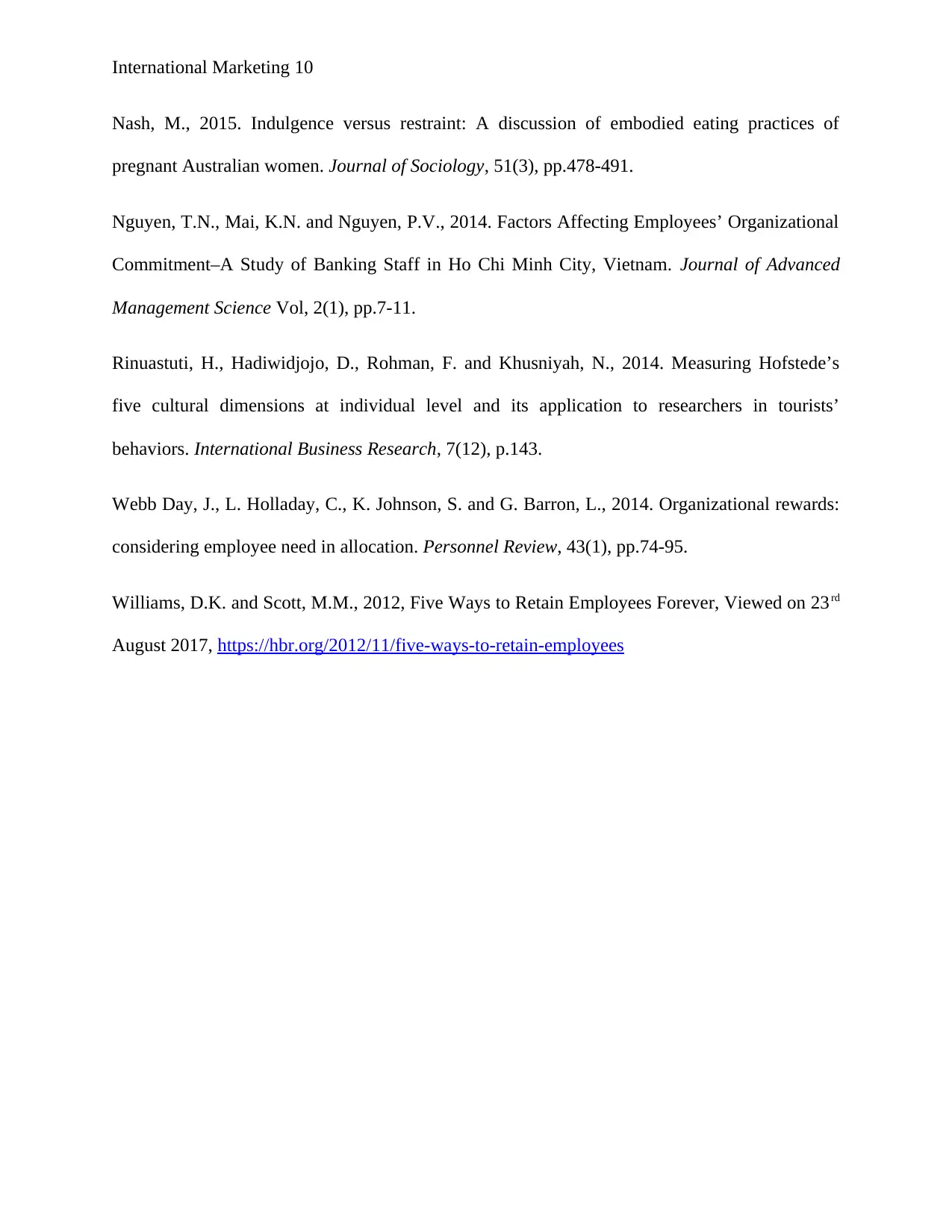
International Marketing 10
Nash, M., 2015. Indulgence versus restraint: A discussion of embodied eating practices of
pregnant Australian women. Journal of Sociology, 51(3), pp.478-491.
Nguyen, T.N., Mai, K.N. and Nguyen, P.V., 2014. Factors Affecting Employees’ Organizational
Commitment–A Study of Banking Staff in Ho Chi Minh City, Vietnam. Journal of Advanced
Management Science Vol, 2(1), pp.7-11.
Rinuastuti, H., Hadiwidjojo, D., Rohman, F. and Khusniyah, N., 2014. Measuring Hofstede’s
five cultural dimensions at individual level and its application to researchers in tourists’
behaviors. International Business Research, 7(12), p.143.
Webb Day, J., L. Holladay, C., K. Johnson, S. and G. Barron, L., 2014. Organizational rewards:
considering employee need in allocation. Personnel Review, 43(1), pp.74-95.
Williams, D.K. and Scott, M.M., 2012, Five Ways to Retain Employees Forever, Viewed on 23rd
August 2017, https://hbr.org/2012/11/five-ways-to-retain-employees
Nash, M., 2015. Indulgence versus restraint: A discussion of embodied eating practices of
pregnant Australian women. Journal of Sociology, 51(3), pp.478-491.
Nguyen, T.N., Mai, K.N. and Nguyen, P.V., 2014. Factors Affecting Employees’ Organizational
Commitment–A Study of Banking Staff in Ho Chi Minh City, Vietnam. Journal of Advanced
Management Science Vol, 2(1), pp.7-11.
Rinuastuti, H., Hadiwidjojo, D., Rohman, F. and Khusniyah, N., 2014. Measuring Hofstede’s
five cultural dimensions at individual level and its application to researchers in tourists’
behaviors. International Business Research, 7(12), p.143.
Webb Day, J., L. Holladay, C., K. Johnson, S. and G. Barron, L., 2014. Organizational rewards:
considering employee need in allocation. Personnel Review, 43(1), pp.74-95.
Williams, D.K. and Scott, M.M., 2012, Five Ways to Retain Employees Forever, Viewed on 23rd
August 2017, https://hbr.org/2012/11/five-ways-to-retain-employees
1 out of 11
Related Documents
Your All-in-One AI-Powered Toolkit for Academic Success.
+13062052269
info@desklib.com
Available 24*7 on WhatsApp / Email
![[object Object]](/_next/static/media/star-bottom.7253800d.svg)
Unlock your academic potential
Copyright © 2020–2025 A2Z Services. All Rights Reserved. Developed and managed by ZUCOL.





